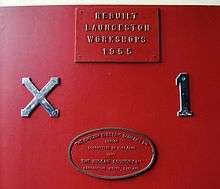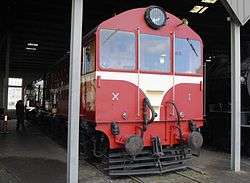Tasmanian Government Railways X class
|
Preserved X1 at the Tasmanian Transport Museum in August 2011 | |||||||||||||||||||||||||
| |||||||||||||||||||||||||
| |||||||||||||||||||||||||
| |||||||||||||||||||||||||
| |||||||||||||||||||||||||
The X class was a class of diesel locomotives built by English Electric for the Tasmanian Government Railways between 1950 and 1952. They were the first class of diesel locomotive, to enter mainline service on a Government-owned railway in Australia.
History

In 1946, the Tasmanian Government Railways put out a request for tender for the construction of five to ten diesel-electric locomotives, which was successfully awarded to English Electric. Following a review of the tender in 1948, it was decided to order a second batch of ten, and finally a third batch of twelve in 1949.[1]
Introduction
Delivered by English Electric between September 1950 and December 1952, the first 20 were manufactured by the Vulcan Foundry under contract to English Electric, and the remaining 12 at Dick Kerr works.[2][3] The first two units entered service on the Tasmanian mainline railways on the 13 September 1950.[1][4]
The X Class was the first locomotive design in Australia to have a multi-unit capacity, with the possibility of operating up to three engines in tandem all controlled from the leading locomotive.
No members of the class were named after entering service, however X16 was named Festival of Britain in 1951 after it was displayed at the aforementioned exhibition.[1]
In service

Primarily designed for branch line and shunting services, the X class proved very successful on main line heavy goods duties as well. Their light axle loading made it possible for them to work on a wide variety of lines, and for many years after their introduction the X class were the dominant freight-hauler on Tasmanian railways. They were also used on passenger trains.[5]
Starting in April 1954 and working until July 1978, the Tasman Limited, Tasmania's premier passenger train, was hauled primarily by the X class. From 1960 they were often used in multiple on the train, and when Tasmania's passenger trains were ceased on 28 July 1978; X20, X16, X29 and X17 hauled the last Tasman Limited from Hobart to Wynyard. This was the last regular passenger service to operate in Tasmania.[1]
In March 1978 the X class were included in the transfer of the Tasmanian Government Railways to Australian National. With the new transfer of twenty 830 class locomotives from South Australia and later purchase of ZB class and ZC class locomotives from Queensland Rail, the X class began to be withdrawn.
The first was withdrawn in October 1980. Units were withdrawn as they became due for major overhauls. With new locomotives in the fleet, and the change from vacuum-braked to air-braked rolling stock, X10 and X18 were the last in mainline service, often hauling the "Paper Train" to Australian Newsprint Mills' Boyer plant. Although remaining in a very serviceable condition, the last X classes were made redundant in 1988 with the cessation of vacuum braked services.[4]
Seven locomotives from the class have been preserved. Many have seen continued service on Tasmanian railways as special passenger trains, but at the present time there is no activity because of the state government suspension of heritage rail on active lines.[1]
XA Class
During the introduction of the more powerful, albeit slower Y class in 1961, it was found that X class engines were susceptible to overheating when working in multiple with Y classes on slow, heavy trains. This was due to a design flaw which prevented the X class from running for a prolonged period at low speed under load. As a result, five were rewired between 1961 and 1970 to give better operation at low speed and reclassified as the XA class.[1][6]
As well as addressing overheating issues, the modifications allow the engines to work better on the grades on the southern region of the Main Line.
General modifications
Apart from the modifications to form the XA class, new automatic couplers and retractable buffers were fitted to most units, and side ladders and roof handrails were added to all units from 1956. Several units also had sliding windows installed as a result of complaints from engine crews that the engines were uncomfortable to operate in summer.
In addition, some units were constructed with eight sandboxes whilst normally each had four. X16 would also lack roof handrails over the cab area until fairly late, and XA class member had a metal bar welded underneath the cab windows across the full width of the cab. The reasons for these modification remain unclear, but are most likely to have been specially built for testing or experimental purposes.[6]
Livery

Upon their initial construction and delivery, all units of this class were painted Brunswick green; however, this colour tended to blend into the Tasmanian countryside, resulting in several accidents at level crossings. To enhance visibility, some units of the class had broad cream bands or an orange chevron painted on the ends.
From the mid 1950s, all units were painted into TGR's new red and cream livery.[1] In 1970 a red, black and yellow tiger stripes livery was introduced.[6]
After control of Tasmanian rail lines was passed to Australian National in March 1978, most units retained their old yellow livery, but with ANR signwriting. Four were repainted into Australian National's green and yellow livery.
Status table
| X class no | XA class no | Last owner | Status |
|---|---|---|---|
| X1 | Tasmanian Transport Museum, Glenorchy | Preserved, operational[4][7] | |
| X2 | AN Tasrail | Withdrawn October 1980, scrapped | |
| X3 | Bellarine Railway, Victoria | Preserved, operational[8] | |
| X4 | Don River Railway, Devonport | Preserved, operational[9] | |
| X5 | AN Tasrail | Scrapped | |
| X6 | AN Tasrail | Scrapped | |
| X7 | AN Tasrail | Scrapped | |
| X8 | AN Tasrail | Scrapped | |
| X9 | XA1 | AN Tasrail | Scrapped |
| X10 | Derwent Valley Railway | Withdrawn August 1988, Preserved, operational[10] | |
| X11 | AN Tasrail | Scrapped | |
| X12 | XA2 | AN Tasrail | Scrapped |
| X13 | AN Tasrail | Scrapped | |
| X14 | XA3 | AN Tasrail | Scrapped |
| X15 | AN Tasrail | Scrapped | |
| X16 | AN Tasrail | Scrapped | |
| X17 | AN Tasrail | Scrapped | |
| X18 | Derwent Valley Railway | Withdrawn August 1988, Preserved, operational[10] | |
| X19 | AN Tasrail | Scrapped | |
| X20 | Bellarine Railway, Victoria | Preserved, operational[8] | |
| X21 | AN Tasrail | Scrapped | |
| X22 | XA4 | AN Tasrail | Scrapped |
| X23 | AN Tasrail | Scrapped | |
| X24 | AN Tasrail | Scrapped | |
| X25 | AN Tasrail | Scrapped | |
| X26 | AN Tasrail | Scrapped | |
| X27 | AN Tasrail | Scrapped | |
| X28 | XA5 | AN Tasrail | Scrapped |
| X29 | AN Tasrail | Scrapped | |
| X30 | Derwent Valley Railway | Preserved, static[10] | |
| X31 | AN Tasrail | Scrapped | |
| X32 | AN Tasrail | Scrapped | |
See also
- Former Tasmanian Government Railways locomotives
- Locomotives of the Tasmanian Government Railways/1950
References
- 1 2 3 4 5 6 7 X & XA Class Rail Tasmania
- ↑ Tasmanian Government Railways Vulcan Locomotives 1950
- ↑ X Class (Tasmania) Railpage
- 1 2 3 Exhibit - X1 Rail Tasmania
- ↑ Oberg, Leon (1984). Locomotives of Australia 1850s-1980s. Frenchs Forest: Reed Books. p. 188. ISBN 0 730100 05 7.
- 1 2 3 Milne, R (2000). Working Class Beauty: A tribute to the TGR X and XA classes. Elizabeth, South Australia: Railmac Publications. p. 24. ISBN 1864770171.
- ↑ "Tasmania" Railway Digest December 1985 page 377
- 1 2 Diesel locomotives Bellarine Railway
- ↑ Locomotives Don River Railway
- 1 2 3 Derwent Valley Railway Rail Tasmania
